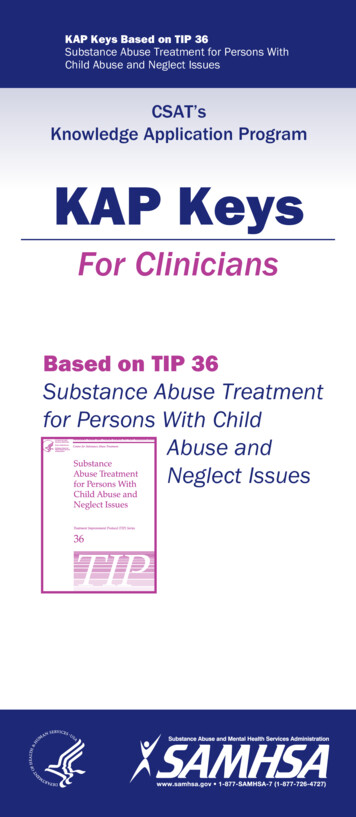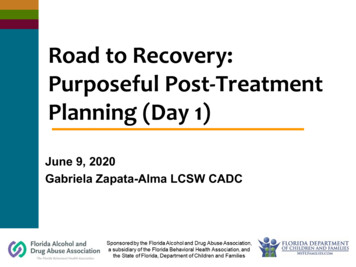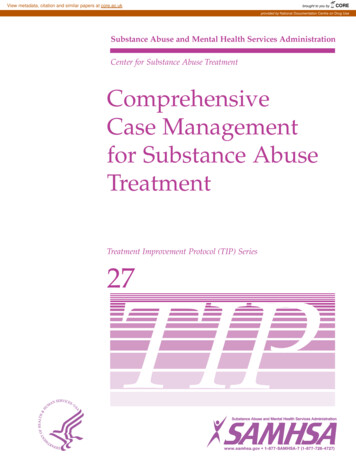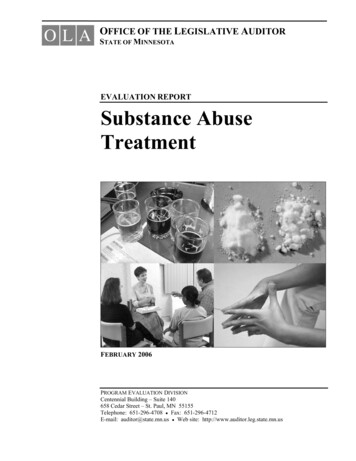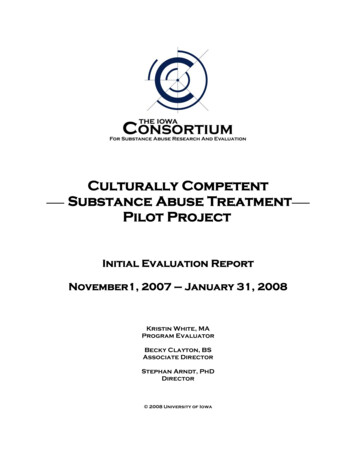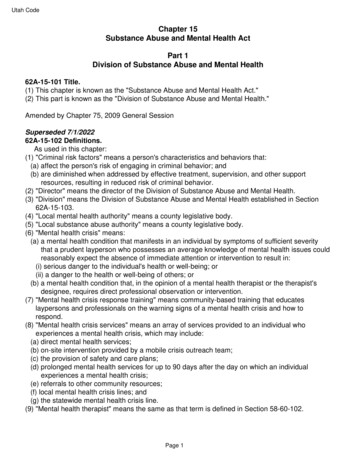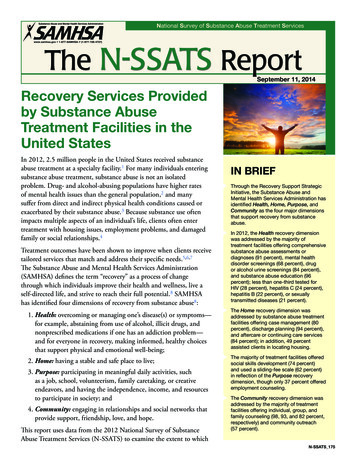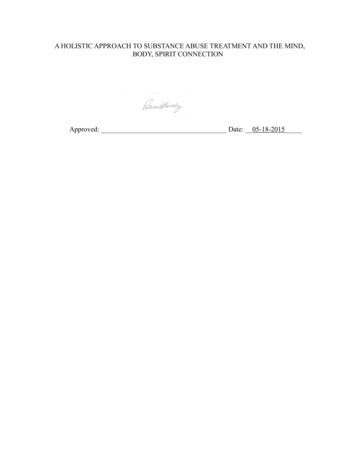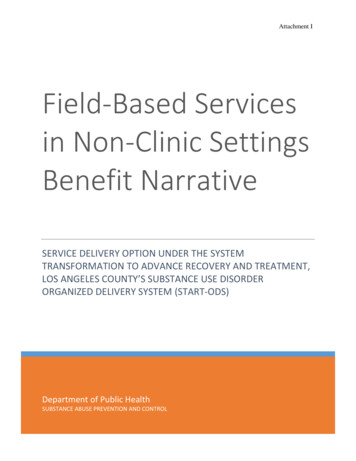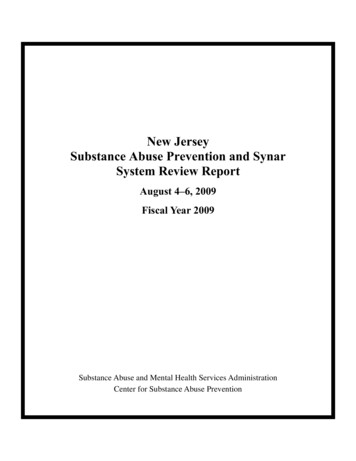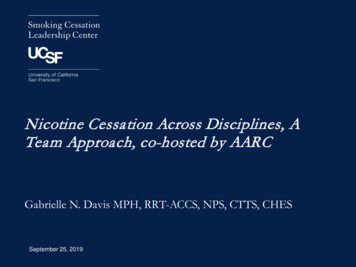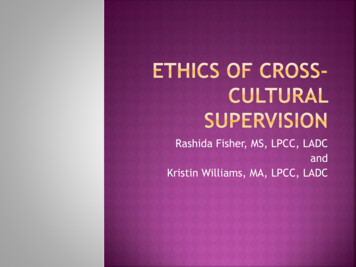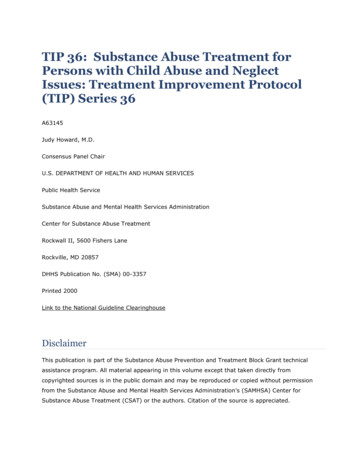
Transcription
TIP 36: Substance Abuse Treatment forPersons with Child Abuse and NeglectIssues: Treatment Improvement Protocol(TIP) Series 36A63145Judy Howard, M.D.Consensus Panel ChairU.S. DEPARTMENT OF HEALTH AND HUMAN SERVICESPublic Health ServiceSubstance Abuse and Mental Health Services AdministrationCenter for Substance Abuse TreatmentRockwall II, 5600 Fishers LaneRockville, MD 20857DHHS Publication No. (SMA) 00-3357Printed 2000Link to the National Guideline ClearinghouseDisclaimerThis publication is part of the Substance Abuse Prevention and Treatment Block Grant technicalassistance program. All material appearing in this volume except that taken directly fromcopyrighted sources is in the public domain and may be reproduced or copied without permissionfrom the Substance Abuse and Mental Health Services Administration's (SAMHSA) Center forSubstance Abuse Treatment (CSAT) or the authors. Citation of the source is appreciated.
This publication was written under contract number 270-95-0013 with The CDM Group, Inc.(CDM). Sandra Clunies, M.S., I.C.A.D.C., served as the CSAT government project officer. RoseM. Urban, L.C.S.W., J.D., C.C.A.S., served as the CDM TIPs project director. Other CDM TIPspersonnel included Raquel Ingraham, M.S., project manager; Jonathan Max Gilbert, M.A.,managing editor; Cara Smith, production editor; Kurt S. Olsson, former editor/writer; PaulSeaman, former acting editor; Y-Lang Nguyen, former production editor; and MaryLou Leonard,former project manager. Special thanks go to consulting writers Tracy Simpson, Ph.D., andChristine Courtois, Ph.D., for their considerable contributions to this document.The opinions expressed herein are the views of the Consensus Panel members and do not reflectthe official position of CSAT, SAMHSA, or the U.S. Department of Health and Human Services(DHHS). No official support or endorsement of CSAT, SAMHSA, or DHHS for these opinions or forparticular instruments or software that may be described in this document is intended or shouldbe inferred. The guidelines proffered in this document should not be considered as substitutes forindividualized client care and treatment decisions.What Is a TIP?Treatment Improvement Protocols (TIPs) are best practice guidelines for the treatment ofsubstance abuse, provided as a service of the Substance Abuse and Mental Health ServicesAdministration's Center for Substance Abuse Treatment (CSAT). CSAT's Office of Evaluation,Scientific Analysis and Synthesis draws on the experience and knowledge of clinical, research,and administrative experts to produce the TIPs, which are distributed to a growing number offacilities and individuals across the country. The audience for the TIPs is expanding beyondpublic and private substance abuse treatment facilities as alcoholism and other substance abusedisorders are increasingly recognized as major problems.The TIPs Editorial Advisory Board, a distinguished group of substance abuse experts andprofessionals in such related fields as primary care, mental health, and social services, workswith the State Alcohol and Other Drug Abuse Directors to generate topics for the TIPs based onthe field's current needs for information and guidance.After selecting a topic, CSAT invites staff from pertinent Federal agencies and nationalorganizations to a Resource Panel that recommends specific areas of focus as well as resourcesthat should be considered in developing the content of the TIP. Then recommendations arecommunicated to a Consensus Panel composed of non-Federal experts on the topic who havebeen nominated by their peers. This Panel participates in a series of discussions; the information
and recommendations on which they reach consensus form the foundation of the TIP. Themembers of each Consensus Panel represent substance abuse treatment programs, hospitals,community health centers, counseling programs, criminal justice and child welfare agencies, andprivate practitioners. A Panel Chair (or Co-Chairs) ensures that the guidelines mirror the resultsof the group's collaboration.A large and diverse group of experts closely reviews the draft document. Once the changesrecommended by these field reviewers have been incorporated, the TIP is prepared forpublication, in print and online. The TIPs can be accessed via the Internet on the National Libraryof Medicine's home page at the URL: http://text.nlm.nih.gov. The move to electronic media alsomeans that the TIPs can be updated more easily so they continue to provide the field with stateof-the-art information.Although each TIP strives to include an evidence base for the practices it recommends, CSATrecognizes that the field of substance abuse treatment is evolving and that research frequentlylags behind the innovations pioneered in the field. A major goal of each TIP is to convey "frontline" information quickly but responsibly. For this reason, recommendations proffered in the TIPare attributed to either Panelists' clinical experience or the literature. If there is research tosupport a particular approach, citations are provided.This TIP, Substance Abuse Treatment for Persons With Child Abuse and Neglect Issues, examinestreatment issues for both adult survivors of child abuse or neglect and adults in treatment whomay be abusing or neglecting their own children.Chapters 1 through 3 focus primarily on adult survivors of child abuse and neglect. Chapter 1defines child abuse and neglect, provides rates of child abuse and neglect both in the generalpopulation and among those in substance abuse treatment, and reviews the literature on linksbetween childhood abuse and subsequent substance abuse. Chapter 2 describes screening andassessment tools that can be used to determine whether a client has a history of childhoodabuse or neglect; Chapter 3 presents guidelines on treating clients with histories of child abuseor neglect and referring them to mental health care treatment when necessary. Chapter 4discusses the personal issues counselors may encounter (e.g., countertransference) whenworking with clients with histories of abuse or neglect and offers suggestions for addressingthem. In Chapters 5 and 6, the focus shifts to adults in treatment who may be abusing orneglecting their own children. Chapter 5 shows how alcohol and drug counselors can identifywhether their clients are at risk of or are currently abusing or neglecting their children. Itdiscusses what alcohol and drug counselors can do to break the cycle of child abuse and neglect,
including how to work with child protective service agencies within the child welfare system.Chapter 6 is an overview of the legal issues that counselors should be aware of as mandatedreporters. The TIP concludes with an overview in Chapter 7 of continuing and emerging trends,such as fast-track adoption and welfare reform, that counselors will need to follow in the comingyears.Other TIPs may be ordered by contacting SAMHSA's National Clearinghouse for Alcohol and DrugInformation (NCADI), (800) 729-6686 or (301) 468-2600; TDD (for hearing impaired), (800)487-4889.
ContentsEditorial Advisory BoardConsensus PanelForewordExecutive Summary and RecommendationsChapter 1—Working With Child Abuse and Neglect IssuesChapter 2—Screening and Assessing Adults For Childhood Abuse and NeglectChapter 3—Comprehensive Treatment for Adult Survivors of Child Abuse andNeglectChapter 4—Therapeutic Issues for CounselorsChapter 5—Breaking the Cycle: The Substance-Dependent Client asParent/CaregiverChapter 6—Legal Responsibilities and RecourseChapter 7—Emerging and Continuing IssuesAppendix A --BibliographyAppendix B --Protecting Clients' PrivacyAppendix C --Implications of Recent Federal Legislation for Clients inTreatmentAppendix D—Obtaining Screening and Assessment ToolsAppendix E --Resources Related to Childhood Trauma Among AdultsAppendix F --Resource PanelistsAppendix G—Field Reviewers
TIP 36: Editorial Advisory BoardKaren Allen, Ph.D., R.N., C.A.R.N.Professor and ChairDepartment of NursingAndrews UniversityBerrien Springs, MichiganRichard L. Brown, M.D., M.P.H.Associate ProfessorDepartment of Family MedicineUniversity of Wisconsin School of MedicineMadison, WisconsinDorynne Czechowicz, M.D.Associate DirectorMedical/Professional AffairsTreatment Research BranchDivision of Clinical and Services ResearchNational Institute on Drug AbuseRockville, MarylandLinda S. Foley, M.A.Former DirectorProject for Addiction Counselor TrainingNational Association of State Alcohol and Drug Abuse DirectorsWashington, D.C.Wayde A. Glover, M.I.S., N.C.A.C. IIDirector
Commonwealth Addictions Consultants and TrainersRichmond, VirginiaPedro J. Greer, M.D.Assistant Dean for Homeless EducationUniversity of Miami School of MedicineMiami, FloridaThomas W. Hester, M.D.Former State Director, Substance Abuse ServicesDivision of Mental Health, Mental Retardation and Substance AbuseGeorgia Department of Human ResourcesAtlanta, GeorgiaJames G. (Gil) Hill, Ph.D.DirectorOffice of Substance AbuseAmerican Psychological AssociationWashington, D.C.Douglas B. Kamerow, M.D., M.P.H.DirectorOffice of the Forum for Quality and Effectiveness in Health CareAgency for Health Care Policy and ResearchRockville, MarylandStephen W. LongDirectorOffice of Policy AnalysisNational Institute on Alcohol Abuse and AlcoholismRockville, Maryland
Richard A. Rawson, Ph.D.Executive DirectorMatrix Center and Matrix Institute on AddictionDeputy Director, UCLA Addiction Medicine ServicesLos Angeles, CaliforniaEllen A. Renz, Ph.D.Former Vice President of Clinical SystemsMEDCO Behavioral Care CorporationKamuela, HawaiiRichard K. Ries, M.D.Director and Associate ProfessorOutpatient Mental Health Services and Dual Disorder ProgramsHarborview Medical CenterSeattle, WashingtonSidney H. Schnoll, M.D., Ph.D.ChairmanDivision of Substance Abuse MedicineMedical College of VirginiaRichmond, Virginia
TIP 36: Consensus PanelChairJudy Howard, M.D.Professor of PediatricsDevelopmental Studies ProgramDepartment of PediatricsSchool of MedicineUniversity of California at Los AngelesLos Angeles, CaliforniaWorkgroup LeadersLynn Dorman, Ph.D., J.D.Brattleboro, VermontDavid Duncan, Dr.P.H., C.A.S.Associate ProfessorCenter for Alcohol and Addiction StudiesBrown UniversityProvidence, Rhode IslandJerry P. Flanzer, D.S.W., L.C.S.W., C.A.C.DirectorRecovery and Family Treatment, Inc.Alexandria, VirginiaMarie Littlejohn, M.S.W., C.S.W.Director of Social WorkMaternity Infant CareMedical and Health Research AssociationNew York, New York
Joan E. Massaquoi, M.S.W., L.C.S.W., B.C.D.Chicago, IllinoisThomas J. McMahon, Ph.D.Assistant Professor of PsychologySubstance Abuse CenterYale School of MedicineNew Haven, ConnecticutPanelistsSarah A. AddlesbergerProgram CoordinatorCastle Medical CenterOcean View, HawaiiChristian A. Akiwowo, Ph.D.President/Chief Executive OfficerAlajobi Rehabilitative ServicesOlympia Fields, IllinoisDarlene Allen, M.S.DirectorChild Welfare ServicesChildren's Friend and ServicesProvidence, Rhode IslandMichael D. De Bellis, M.D.Assistant Professor of PsychiatryDevelopmental Traumatology LaboratoryUniversity of Pittsburgh Medical CenterPittsburgh, Pennsylvania
Pamela L. Donaldson, A.R.N.P-C., C.A.R.N, Ph.D.Post-Doctoral FellowNew York State Psychiatric InstituteColumbia UniversityHackensack, New JerseyJames Herrera, M.A., L.P.C.C.Center on Alcoholism, Substance Abuse and AddictionsUniversity of New MexicoAlbuquerque, New MexicoMargo H. Juarez, L.A.D.A.C., R.I.M.H.C.Albuquerque Metropolitan Central IntakeAlbuquerque, New MexicoLewis Jay Lester, M.S.W., L.C.S.W.Briceland, CaliforniaHerschel Swinger, Ph.D.Children's Institute InternationalLos Angeles, California
ForewordThe Treatment Improvement Protocol (TIP) series fulfills SAMHSA/CSAT's mission to improvetreatment of substance abuse by providing best practices guidance to clinicians, programadministrators, and payors. TIPs are the result of careful consideration of all relevant clinical andhealth services research findings, demonstration experience, and implementation requirements.A panel of non-Federal clinical researchers, clinicians, program administrators, and clientadvocates debates and discusses their particular area of expertise until they reach a consensuson best practices. This panel's work is then reviewed and critiqued by field reviewers.The talent, dedication, and hard work that TIPs panelists and reviewers bring to this highlyparticipatory process have bridged the gap between the promise of research and the needs ofpracticing clinicians and administrators. We are grateful to all who have joined with us to contributeto advances in the substance abuse treatment field.Nelba Chavez, Ph.D.AdministratorSubstance Abuse and Mental Health Services AdministrationH. Westley Clark, M.D., J.D., M.P.H, CAS, FASAMDirectorCenter for Substance Abuse TreatmentSubstance Abuse and Mental Health Services Administration
TIP 36: Executive Summary andRecommendationsChild abuse and neglect pose an increasingly recognized and serious threat to the nation'schildren. The reported cases of abused and neglected children have more than doubled from 1.4million in 1986 to more than 3 million in 1997. Research suggests that adults with histories ofchild abuse and neglect are at high risk for developing substance abuse disorders. Moreover,these childhood abuse and neglect issues may negatively affect clients' chances for recoveryfrom substance abuse. Compounded with these problems is the increased likelihood ofsubstance-abusing parents abusing their own children. By most accounts, substance abusecontributes to almost three fourths of the incidents of child abuse or neglect for children in fostercare.Two major reports released in 1999 highlight the need to address this intergenerational cycle ofsubstance abuse and child abuse if effective progress is to be made on either problem. Thesestudies are Blending Perspectives and Building Common Ground: A Report to Congress onSubstance Abuse and Child Protection by the U.S. Department of Health and Human Services(DHHS) and No Safe Haven: Children of Substance-Abusing Parents by the National Center onAddiction and Substance Abuse (CASA) at Columbia University. Both reports emphasize that therise in substance abuse as a factor in child abuse and neglect cases has severely complicatedefforts by child welfare systems to protect children and rehabilitate families. In response to theseissues, this Treatment Improvement Protocol (TIP) presents information to assist alcohol anddrug counselors and other treatment providers to work more effectively with adults who havehistories of childhood abuse or neglect and adults who abuse or who are at risk for abusing theirown children.The effects of childhood abuse and neglect perpetrated by family members and theintergenerational transmission of the cycle of substance abuse and child abuse and neglect arethe focus of this TIP. However, not all clients in treatment have a history of childhood abuse, notall children who are maltreated become substance abusers or child abusers, and not all child
abusers have a history of childhood abuse or current substance abuse. Although these arecommon factors that often arise in substance abuse treatment, they are not present in everycase.This TIP does not address the treatment needs of children who are currently being abused, asthat area of concern is extensively addressed in multidisciplinary literature. This TIP also doesnot address children who are abusing substances, many of whom may have experienced abuseand neglect. The issues involved in treating children and adolescents for substance abuse differgreatly from those encountered with an adult client population. Guidelines for screening,assessing, and treating adolescents with substance abuse disorders are offered in TIP 31,Screening and Assessment of Adolescents for Substance Use Disorders (CSAT, 1999a), and TIP32, Treatment of Adolescents With Substance Use Disorders (CSAT, 1999b). A third group notaddressed here is pedophiles. The Consensus Panel considers pedophilia to be a separatecategory of child sexual abuse beyond the scope of this document. The most pervasive form ofchild maltreatment is neglect (60 percent); however, because most research has focused onchildhood physical and sexual abuse, this TIP will primarily address these two forms.Definitions of the types of behaviors and specific acts that constitute physical, emotional, andsexual abuse and neglect are provided in Chapter 1 so that counselors can better understand therange of potential experiences of their clients. In Chapter 2, the TIP discusses common signs andbehaviors that suggest a history of childhood emotional, physical, and sexual abuse and neglect,as well as indicators that clients might be abusing their own children. Chapter 3 addresses thedistinct treatment issues that counselors may encounter in working with adults who have beenabused or neglected in childhood. Among the factors that can complicate treatment for thispopulation are comorbid mental disorders and trauma-related symptoms.Because of the abhorrent nature of child abuse and the emotional difficulty of working withtraumatized individuals and with individuals who harm children, personal issues for counselorsare discussed throughout this TIP and are the focus of Chapter 4. Substance-abusing parentswho may be abusing or neglecting their children are the subject of Chapter 5. In working withchild abusers, many of whom are ordered into treatment by the courts, treatment counselors
must understand the structure of the child protective services (CPS) system and the family andcriminal courts in order to help clients negotiate these systems. The TIP provides someguidelines for communicating with these systems; however, treatment providers must learn theparticulars of how these services are structured in their State and local jurisdictions. Chapter 6discusses the relevant laws on reporting current child abuse and maintaining clientconfidentiality; recent legislation on family preservation, fast-track adoption, and reunificationlaws are reviewed in Chapter 7.Throughout this TIP, the term "substance abuse" has been used in a general sense to cover bothsubstance abuse disorders and substance dependence disorders (as defined by the Diagnosticand Statistical Manual of Mental Disorders, 4th Edition [DSM-IV] American PsychiatricAssociation, 1994). Because the term "substance abuse" is commonly used by substance abusetreatment professionals to describe any excessive use of addictive substances, in this TIP it willbe used to denote both substance dependence and substance abuse disorders. The term relatesto the use of alcohol as well as other substances of abuse. Readers should attend to the contextin which the term occurs in order to determine what possible range of meanings it covers; inmost cases, however, the term will refer to all varieties of substance use disorders as describedby DSM-IV.To avoid both sexism and awkward sentence construction, the TIP alternates between thepronouns "he" and "she" in generic examples.RecommendationsThe Consensus Panel's recommendations, summarized below, are based on both research andclinical experience. Those supported by scientific evidence are followed by (1); clinically basedrecommendations are marked (2). Citations to the former are referenced in the body of thisdocument, where the guidelines are presented in detail.The Consensus Panel recommends that, when working with clients with substance abuseproblems and histories of childhood abuse and neglect, counselors adopt a broad approach thatconsiders the meaning of the experience to the client, not just legal definitions of child abuse and
neglect. (1) Counselors must, therefore, understand how clients interpret their experiences. Notall abuse meets the legal or commonly held criteria for abuse, nor do all clients perceive asabusive behavior that which might be legally defined as "abuse."Screening and AssessmentWithout proper screening and assessment, treatment providers may wrongly attribute symptomsof childhood trauma-related disorders to consequences of current substance abuse.Comprehensive screening for root causes of clients' presenting symptoms may greatly increasethe effectiveness of treatment. However, counselors face many challenges when screening forand assessing childhood abuse or neglect. Many abuse survivors are ashamed of having beenvictims of childhood physical, emotional, or sexual abuse and may believe that the abuse wasself-induced. Screening and assessment, therefore, should be designed to reduce the threat ofhumiliation and blame and should be done in a safe, nonthreatening environment. (2)While conducting screenings and assessments, counselors should be mindful that adult survivorsof childhood trauma commonly suppress memories of certain traumatic events or minimize theirsymptoms, either intentionally or unintentionally. Moreover, issues of confidentiality, mandatedreporting, and trust may influence the responses to interviews and questionnaires by makingsome clients less inclined to reveal personal histories of abuse or neglect. Given the variablereliability of clients' responses, counselors should neither overemphasize nor overvalue the roleof standardized instruments.Counselor issuesCounselors who will be screening for and assessing histories of child abuse or neglect shouldreceive specific training in these areas. (2) Although there are no rigid rules regarding whoshould conduct screenings, having certain skills will increase the likelihood that the screeningprocess is conducted appropriately. Staff members should have an understanding of the types ofpsychiatric disorders and symptoms that are commonly associated with histories of childhoodabuse and neglect.
Counselors who conduct screenings will be prompting clients to recall painful and traumaticevents. The reemergence of painful memories may cause intense reactions from clients.Treatment staff should be sensitive to this and prepare for the interview in the following ways: Inform clients that talking about such issues might create discomfort; clientsshould be given a choice to disclose such information, being aware of thepossible aftermath. (2) Have proper supervision and support mechanisms in place for clients in case acrisis occurs following disclosure (e.g., accessibility to mental healthpractitioners or medical personnel). (2) Assess the sources of social and emotional support available to clients whenthey return home. (2)There are many potential barriers to successful screenings and assessments of childhood trauma.To reduce some of these barriers, the Consensus Panel recommends the following: Be sensitive to cultural concerns. (1) Recognize potential language differences. (2) Become aware of gender issues. (2) Be nonjudgmental and sensitive. (1)If counselors experience intense discomfort and anxiety when conducting screenings andassessments, the Consensus Panel recommends that they receive guidance and support from aclinical supervisor and consider whether they could benefit from therapeutic assistance to explorethe reasons for their discomfort. (2) A variety of instruments for screening and assessment arediscussed in Chapter 2.ScreeningThe Consensus Panel suggests screening for child abuse and neglect histories early in theassessment process to identify individuals who exhibit signs and symptoms associated with childabuse and neglect (such as posttraumatic stress disorder [PTSD], major depression, or mood
disorders) and to identify those who may benefit from a comprehensive clinical assessment. (2)Screenings should also be conducted at different times throughout the treatment process.Repeated screenings help elicit information about these traumatic experiences--especially aftertrust has been established in the therapeutic relationship. (2) To conduct a screening effectively,treatment staff should Learn and understand ways in which childhood abuse and neglect can affectadult feelings and behaviors. (2) Identify those individuals who appear to exhibit these symptoms. (2) Identify the trauma-related treatment needs of these clients. (2) Provide or coordinate appropriate treatment services that will help meet clients'treatment needs. (2)Screening for childhood abuse or neglect can set in motion a proactive plan with the followingbenefits: Stopping the cycle. Although not all adults who were abused or neglectedduring childhood abuse their own children, they are at greater risk for doing so.(1) Decreasing the probability of relapse. Many substance abusers consumesubstances to self-medicate posttraumatic stress symptoms related to pastphysical or sexual abuse or trauma. (1) Improving a client's overall psychological and interpersonal functioning.Childhood sexual abuse and neglect may affect the individual's self-concept,sense of self-esteem, and ability to self-actualize. (2) Improving program outcome. Screening for a history of child abuse or neglectwill help a program to determine the needs of its clients, thus improvingtreatment outcomes. (2)AssessmentsThe primary purpose of an assessment is to confirm or discount a positive screening forchildhood abuse or neglect, as well as to identify clients' needs so that treatment can be tailored
to meet them. The more clinical information a program has about clients' particular treatmentneeds, the better the program can accommodate them. All clients who screen positive for ahistory of childhood abuse or neglect should be offered a comprehensive mental healthassessment. (2) There is no standard trauma-oriented assessment tool, and no single tool can beconsidered truly comprehensive. Rather, wisely selected, each of these tools can be a valuablecomponent of a comprehensive assessment process.When deciding whether to conduct assessments for a history of child abuse or neglect, thetreatment team should evaluate clients' Current substance use or quality and length of abstinence Commitment to the treatment and recovery process Risk of relapseThe Consensus Panel believes that treatment decisions and activities are best conducted withinthe context of a multidisciplinary treatment team, with members having special knowledge insuch areas as mental health, child abuse and neglect, and family counseling. (2) Each member ofthe treatment team should help decide if and when to conduct assessments for childhoodtrauma, and clients should be asked to evaluate their own readiness to confront child abuse orneglect issues.Trauma-related assessments are important because they can help the treatment staffunderstand the types of childhood traumatic events experienced by clients, their subjectiveresponse and perceptions of these events, and common current symptoms that may result fromchildhood trauma. Decisions regarding the types of instruments to use should be influenced bythe purpose of the assessment, the setting of the assessment, the population being treated, andthe individual client and the severity of his problems. (2)Assessing histories of childhood trauma can provoke or exacerbate a psychological emergencythat must be addressed; therefore the Consensus Panel recommends that the treatment teaminclude a licensed mental health professional to handle medical issues that may arise and toconduct more formal assessments that may be required.
Subjective experience of the eventsHow clients remember traumatic events can shape their psychological response more than theactual circumstances can; counselors, therefore, need to obtain subjective information aboutthese events. Such information is necessary in order to plan appropriate treatment. Informationthat should be obtained includes: What the client thought about during the abuse What the client felt during the abuse How the client understood, as a child, what was happening to her and what shethinks about it now How the client thinks and feels about how the abuse has affected his adulthoodand substance abuse, and how he deals with the aftereffects of the abuse now The feelings most closely associated with the abuse experience The client's memories of the abuse The unique aspects of the client's perceptions about the abuse The client's coping strategies, and their effectiveness for the clientChildhood symptoms and family characteristicsThe assessment should inquire about childhood symptoms and family characteristics that areconsistent with and suggest a history of childhood abuse or neglect. (2) Symptoms to look forinclude Depression (including thoughts of death, passive suicidal ideation, and feelingsof hopelessness) Dissociative responses during childhood Aggressive behavior or other "acting out," including oEarly sexual activity or sexualized behavioroPhysically abusing or harming pets or other animalsoOther destructive behaviorsPoor relationships with one or both parents
Attachment disorder, difficulty trusting others Excessive passivity Passive/aggressive behavior Inappropriate age/sexuality formation Blacked-out timeframes during childhood Excessive nightmares, extreme fear of the dark, or requested locks on doorsFamily-of-origin characteristics to consider include Parental substance abuse Battering within the family Involvement with CPS agencies or foster care Placement with foster parents or relatives Severe discipline during childhood Traumatic separations and lossesTreatment PlanningA very important factor in predicting treatment success is the number of services clients receive(e.g., case management, parenting education, counseling for PTSD and childhood abuse). (1)Clients receiving more specialized services, often concurrently with substance abuse treatment,are more likely to stay in recovery. (1) Treatment planning for clients with childhood abusehistories should be a dynamic process that can change as new information is uncovered, takinginto account where a client is in the treatment process (e.g., conf
of-the-art information. Although each TIP strives to include an evidence base for the practices it recommends, CSAT . Division of Clinical and Services Research National Institute on Drug Abuse Rockville, Maryland . Linda S. Foley, M.A. . National Institute on Alcohol Abuse and Alcoholism Rockville, Maryland . Richard A. Rawson, Ph.D.
